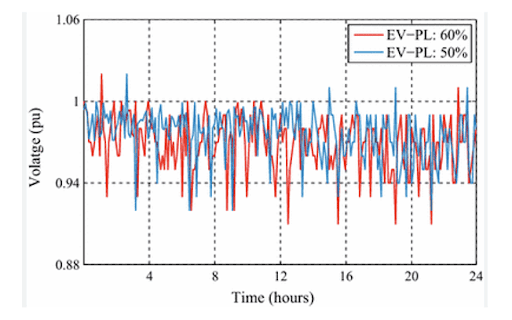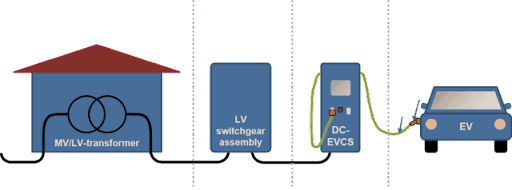The Future of Electric Vehicle (EV) Charging: Exploring Low Voltage Switchboards
Low Voltage Switchboard for EVs Charging
The Surge in Electric Vehicles
A recent analysis by Global Data, a data and analytics company connected to Power Technology, projects that the global electric vehicle market will grow at a significant compound annual growth rate of 15.9% from 2023 to 2035.
The analysis offers a closer look at this trend, estimating that the passenger electric vehicle (EV) market will develop at a compound annual growth rate of 26.1% during the same period, while the commercial EV sector will grow at a slower pace of 15%. By 2035, 44 million battery-electric passenger cars are anticipated to be sold.
In contrast to the 7.3 million units sold in 2022, this suggests a significant increase. The prediction states that the number of battery-electric commercial vehicles sold in the commercial vehicle industry will increase from roughly 400,000 in 2022 to 7.6 million by 2035. Global sales of electric vehicles are expected to reach 51.6 million by 2035.
Growing Importance of EV Charging Infrastructure
For the increased demand for Electric vehicles, an efficient EV charging infrastructure is necessary. The lack of EV charging Infrastructure could be a significant hurdle that will lower EV purchases.
Until recently, the lower range and substantial purchase costs were the only factors considered as the barrier for the EV adaptation. These concerns will be solved with 350 new EV models set to debut by 2025, having a range of 200 miles or more. According to McKinsey's consumer survey, access to an efficient charging station is considered a substantial barrier to EV purchases.
In countries like China, the European Union, and the United States, around 120 million EVs will be on the road by 2023, as shown in Figure 1. In the worst case the figures can get doubled. [1] With this, the total charging energy demand for these countries is predicted to hike up to some 280 billion kilowatt-hours.
The EV industry is required to have a cumulative capital investment of $50 billion to fulfill the total charging energy demand in countries like China, the European Union, and the United States by 2023.
Understanding EV Charging Stations
Types of EV Charging Stations
The bulk of EV charging standards in the US have been established by the Society of Automotive Engineering (SAE), especially with the help of its J1772 Standard. [2] Power, voltage, and current are the three factors that determine the EV charging system level in North America.
This onboard charger has a maximum capacity of 3.3 kW and can operate at an AC voltage of 120 or 240 V with a maximum current of 15 A. Usually used for slow charging in home environments.
Level 2 Charging
There is another onboard charger available that has a maximum power of 14.4 kW, a maximum current of 60 A, and an AC voltage of 240 V. It is found in both public and private settings, enabling faster charging than in Level 1.
Level 3 Charging (DC Fast Charging)
This offboard charger uses a DC connector to send DC directly to the battery at a maximum output of 240 kW. They are used for rapid charging in public spaces.
| Charging Level | Description | Power Output | Typical Charging Time | Suitable Use |
|---|---|---|---|---|
| Level 1 Charging | Slow charging is used at home or office | Up to 1.44 kW (120V, 12A) | 411 hours | Home or office slow charging |
| Level 2 Charging | Faster charging suitable for private or public use | Up to 7.7 kW (240V, 32A) | 26 hours | Primary charging at private or public locations |
| DC Fast Charging | Rapid charging for quick public use | Up to 240 kW (Offboard) | 0.21 hour | Fast charging for public use |
Evolving Trends in EV Charging Technology
The rising demand for electric cars means that charging technologies must keep improving. The need for quicker, more effective charging options, as well as more conventional worries like range anxiety, are driving advancements in EV charging strategies.
Even while onboard chargers (OBCs) that were linked to standard outlets were initially used to assess charging rates, the advent of wide bandgap (WBG) devices signaled the beginning of a revolutionary period in the electronics industry.
WBG devices can run at higher power. Thanks to fast and ultrafast DC charging stations, batteries can be charged straight from the charger output. These stations are essential for reducing range anxiety.
International standards like SAE J2954 and GB/T 38775, which made wireless charging possible, have made life easier. [3] Dynamic online wireless charging may also lower the cost of EVs. The infrastructure's dependability, efficiency, and power density are critical as the EV market expands quickly.
Consequently, technological progress has been decreasing, particularly in the domain of power semiconductor devices such as WBG materials. The transition from silicon-based semiconductors to WBG devices is a paradigm change that opens new avenues for the advancement of EV charging technology and allows for notable increases in charging efficiency.
The Need for Robust Electrical Infrastructure
Challenges in Power Distribution for EV Charging
Power distribution networks face issues with power quality (PQ) and harmonic distortion from electric vehicles. Table 2 describes the THD with respect to charging time.

Voltage fluctuations, transient currents and voltages, and problems with service continuity can all be caused by low PQ.
Power quality is impacted by harmonic distortion, which is mostly connected to nonlinear loads such as EV charging controllers. This study focuses on three scenarios in which distribution feeders are impacted by EV charging.
Firstly, distribution feeders may be impacted by the high-power consumption and nonlinear characteristics of EV charging controllers.
[4] Moreover, variations in the overall harmonic distortion of the pull of the current charge controllers may occur during the charging cycle.
Finally, compared to a single charge controller, the distortion created by several charge controllers operating simultaneously on a feeder may be larger.
Importance of LV Switchboards in Managing Electrical Loads
It is impossible to exaggerate the significance of low voltage (LV) switchboards in controlling electrical loads. LV switchboards effectively distribute electricity as central control units, guaranteeing safe and balanced load management.
These switchboards help electrical systems operate at their best by controlling the flow of electricity and preventing overloads.
When it comes to charging electric vehicles, LV switchboards are essential for stability and disruption avoidance because multiple charging stations use electricity simultaneously throughout this process.
Their importance derives from their ability to maintain security, improve the dependability of electrical systems, and facilitate the smooth operation of various and fluctuating electrical loads.
Role of LV Switchboards in EV Charging
Ensuring Safe Power Distribution
In the context of EV charging, LV switchboards play a critical role in facilitating safe and efficient power distribution.
The LV switchboards serve as central components for controlling and managing the electric power flow from the grid to both the EV battery charger and the various loads within a business.
A sophisticated smart charging management strategy is proposed designed to regulate the current supplied to the EV battery. This strategy is contingent upon monitoring the overall current consumption within the business, thus mitigating the risk of overcurrent scenarios that could lead to disruptions such as tripping of the main breaker.
The proposed approach involves adapting a bidirectional EV battery charger prototype to operate in accordance with this intelligent charging strategy.
The proposed strategy emphasizes the significance of integrating smart charging technologies within the broader framework of smart homes and grids. [5] By dynamically adjusting EV charging current based on real-time home current conditions, the strategy not only prevents disruptions but also contributes to optimized power utilization and efficient integration of electric vehicles into evolving energy ecosystems.
Managing Voltage Fluctuations during Charging
When an EV charger is attached to the power source, this results in an impact that unbalances the voltage, as shown in Figure 3.

Stability is critical to the long-term viability of EVs and the infrastructure that supports their charging, as it increases the efficiency of charging and protects sensitive electrical components. Additionally, it makes the charging environment more stable and secure.
LV Switchboards and Energy Efficiency
Optimizing Power Flow for Sustainable Charging:
LV switchboards are required to maximize power flow and guarantee environmentally friendly charging procedures. Their effective distribution of electrical energy reduces energy loss and improves the overall performance of the EV charging infrastructure. This upgrade encourages energy efficiency, which lowers costs and improves the environmental friendliness of charging.
Integration with Smart Grids for Enhanced Efficiency:
Smart grids and LV switchboards can collaborate smoothly to increase energy efficiency even further. Using smart grid technology makes it easier to monitor and control the distribution of power in real-time, enabling dynamic changes in reaction to changes in availability and demand. This ingenious integration optimizes the charging process, lowers energy waste, and encourages more frugal use of resources by fusing modern smart energy management techniques with EV charging.
Evolution of LV Switchboard Technology
Innovations in LV Switchboard Design:
This study demonstrates how improvements in design have led to further breakthroughs in LV switchboard technology. It focuses on design, fabrication, and assembly innovations that lead to more compact, reliable switchboards. The focus is on ongoing enhancements that increase LV switchboards' overall functionality and adaptability to suit the evolving demands of electric power distribution networks.
Digitalization and Remote Monitoring Capabilities:
An important breakthrough in the evolution of LV switchboards is the addition of digitalization and remote monitoring capabilities. Modern LV switchboards use digital technologies to give real-time control and monitoring. Operators may now assess performance, identify problems remotely, and respond quickly to fix them. LV switchboards become more trustworthy, efficient, and simple to maintain when these features are included. Additionally, they meet the needs of contemporary power distribution networks.
Common Misconceptions about LV Switchboards
Dispelling Myths Surrounding LV Switchboards:
A commonly held misconception is that LV switchboards are intrinsically hazardous. When built and maintained properly, LV switchboards adhere to stringent safety rules, lowering hazards and ensuring safe power distribution.
Some believe that an LV switchboard's complexity and increased safety risks are directly related.
However, design and technological advancements challenge the notion that complexity and susceptibility are associated with enhancing safety features and streamlining procedures.
Addressing Safety Concerns:
The claim that LV switchboards can malfunction on their own is incorrect. By ensuring dependable and safe operation, conducting preventive maintenance, conducting frequent inspections, and abiding by industry norms, unplanned breakdowns are greatly reduced.
A common misconception is that LV switchboards need to catch up with the rate of technological advancement.
Still, if these systems keep advancing, they will be able to incorporate contemporary technology smoothly and adjust to the changing requirements of power distribution networks.
Installation and Maintenance Best Practices
Ensuring Proper Installation of LV Switchboards:
It is essential to remember that LV switchboards are usually kept in safe, secure locations so that only authorized staff may access them. By preventing unwanted interference, this approach improves safety and safeguards the integrity of the electrical system.
By adhering to these recommendations, you enhance the LV switchboard's operating conditions while also promoting a safe, regulated environment that complies with industry best practices.
Regular Maintenance for Longevity and Safety:
Check LV switchboards frequently to ensure they are still secure and operating by quickly identifying and resolving any potential problems.
To minimize wear and tear and eliminate dust formation while ensuring smooth operation, it is recommended to clean components on a regular basis.
Keeping up with technological developments and updating or modernizing LV switchboards makes them more dependable and efficient as well as to align with changing industry standards.
LV Switchboards in Different Charging Environments
Commercial and Public Charging Stations:
Since many electric vehicles are frequently charged in public and commercial settings, LV switchboards are crucial for effectively managing a range of power requirements.
Flexible and safe power distribution to accommodate different loads ensures the dependable and simultaneous charging of many vehicles. By preventing overloads and short circuits, LV switchboards increase user safety.
This is especially important in crowded areas where charging sessions occur one after the other very quickly. For the charging infrastructure to be used safely and effectively, this dependability is essential.
LV switchboards can streamline pricing, invoicing, and service administration in commercial environments by linking with payment systems. This feature makes public charging stations more viable and practicable, which encourages the expanding use of electric vehicles in a variety of scenarios.
Future Trends in LV Switchboard Integration
Anticipated Technological Advancements:
It is anticipated that smart grid technologies will be progressively integrated into future LV switchboards, enabling more responsive and dynamic power distribution.
Real-time communication is made possible by this connection, which also maximizes energy use and increases overall efficacy. [6] A domain in which advancement is anticipated is the integration of Internet of Things (IoT) technology.
This enables proactive management of LV switchboards for increased dependability and decreased downtime by enabling remote monitoring, diagnostics, and predictive maintenance.
Meeting the Growing Demands of EV Charging Infrastructure:
Switchboards can and are typically designed and provisioned for future expansion. To keep up with the growing demand for electric cars and the growing number of charging stations, switchboards must be expandable.
Future developments are expected to concentrate on improving safety protocols even more, resolving issues, and guaranteeing that LV switchboards function securely in a range of increasing charging scenarios.
LV switchboards are developed to smoothly interact with solar and other renewable energy systems as the focus on renewable energy sources develops, facilitating environmentally beneficial and sustainable charging practices.
Case Studies: Successful LV Switchboard Deployments
Highlighting Success Stories in EV Charging
This case study focuses on a novel resilient low-voltage network architecture for distributed generation and broad EV charging.
The case study focuses on the strategic positioning of LV switchboards to effectively address the challenges posed by the increasing need for electric vehicle charging.
In a situation where traditional Low Voltage networks were unprepared for the increase in energy consumption, LV switchboards emerged as a vital component.
Upon simulating the impact of growing electric vehicle adoption on over 1,300 low-voltage lines, the low-voltage switchboards demonstrated exceptional resilience [7].
Using the 6-month simulation, the load growth at the Secondary Substation LV panel level was assessed. The efficacy of the switchboards depended on their capacity to adjust and control the different demand profiles brought forth by sporadic EV use.
The installation of both Basic and Advanced LV Supervision systems allowed for the provision of invaluable real-time data on voltage levels, power flows, and phase imbalances.
Lessons Learned from Real-World Implementations
The case study made it abundantly evident that On-Load Tap Changer (OLTC) transformers were necessary to maintain active voltage control.
These transformers provide a less expensive alternative to traditional grid upgrades by effectively managing the unpredictable oscillations related to EV and distributed energy resources (DER) integration.
The lesson learned was that OLTC transformers may be necessary to maintain constant voltage levels in the face of fluctuating energy needs.
The application of LV feeder automation technology aided in the creation of practical control strategies for widespread EV charging.
Additions such as circuit breakers and electronically operated disconnect switches show how versatile LV switchboards are in handling irregular issues and ensuring independent client reconnection.
We learned from this experience how important dynamic control techniques are for maintaining network integrity.
Frequently Asked LV Switchboard Charging Station Questions
Final Thoughts
LV switchboards are crucial components of the infrastructure needed to charge electric vehicles. The critical role they play in ensuring safe power distribution, resilience to voltage fluctuations, and adapting to different charging scenarios demonstrates their significance.
As the EV environment continues to evolve, improvements in LV switchboard technology and growing demands for charging infrastructure point to an exciting future.
Incorporating LV switchboards into EV charging not only guarantees efficiency and safety in the present but also lays the foundation for a dynamic and sustainable future by dispelling myths, learning from successful implementations, and staying up to date with technological advancements.
References
- R. H. K. S. Hauke Engel, "CHARGING AHEAD: ELECTRICVEHICLE INFRASTRUCTURE DEMAND," october 2018.
- M. C. S. D. B. I. S. &. D. M. Falvo, " EV charging stations and modes: International standards.,"International symposium on power electronics, electrical drives, automation and motion , pp. 1134-1139, june ,2014.
- S. L. S. &. M. C. C. Li, "Revolution of electric vehicle charging technologies accelerated by wide bandgap devices," pp. 985-1003., 2021.
- R. B. &. Z. N. Bass, " Impacts of electric vehicle charging on electric power distribution systems.," 2013.
- V. P. J. G. E. B. F. J. C. &. A. J. L. Monteiro, "Smart charging management for electric vehicle battery chargers.," IEEE Vehicle Power and Propulsion Conference, pp. 1-5, 2014.
- "Dara Switch boards," [Online]. Available: https://electricalswitchboards.com.au/how-switchboards-will-evolve-in-an-age-of-smart-technology/.
- "Merytronic Gorian," [Online]. Available: https://merytronic.gorlan.com/en/resilient-lv-network/
https://www.power-technology.com/news/globaldata-global-ev-growth-forecast-report/

